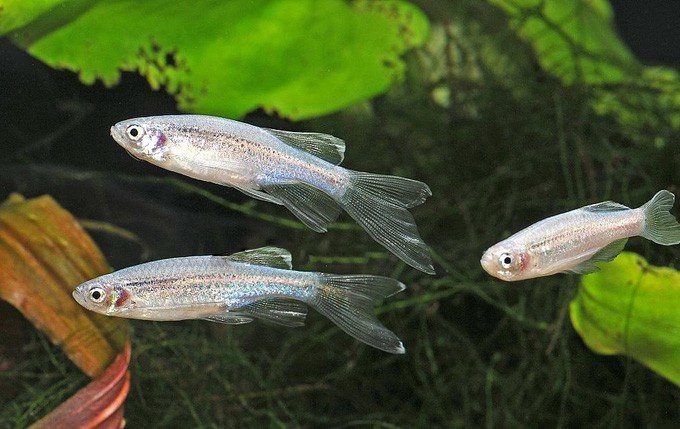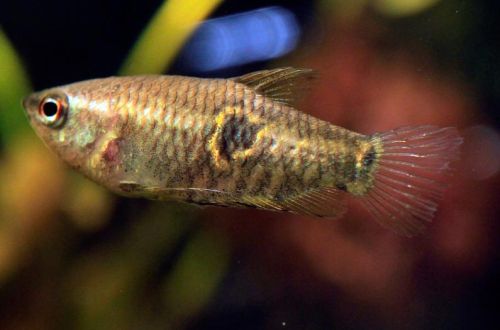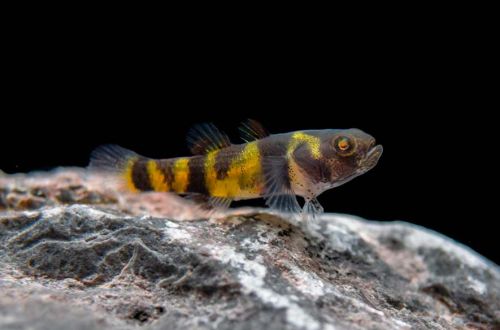
Blue Danio
Blue Danio, scientific name Danio rerio, belongs to the Cyprinidae family. Another variety of the classic Danio Rerio, distinguished by a silver-blue coloration of small specks and long graceful fins. This species appears to have originated from another breeding species, the Leopard Danio, as indicated by the punctate pigmentation of a pattern that looks like a fine blue powder.

Habitat
Blue Danio does not live in natural reservoirs, it was bred artificially as a result of selection of the Leopard Danio species.
Requirements and conditions:
- The volume of the aquarium – from 40 liters.
- Temperature – 18-24°C
- Value pH — 6.0–8.0
- Water hardness – soft to medium hard (5-19 dGH)
- Substrate type – dark fine gravel or sand
- Lighting – subdued
- Brackish water – no
- Water movement – moderate
- Size – up to 4 cm.
- Food – any food floating on the surface
- Life expectancy – from 3 to 4 years
Description

Small slender fish no more than 4 cm, have a laterally compressed body and short antennae at the end of each lip, indicating their relationship with other cyprinids. They are distinguished by their long spreading fins. The coloration of the body consists mainly of a dense scattering of small blue dots, merging into a single background from a distance, and several pronounced pinkish-gold stripes stretching from the tail to the middle of the body.
Food
Fish eats almost everything – live (bloodworm, tubifex), frozen and dry industrial feed. Currently, kits specially made for all types of Danio containing freeze-dried meat products are widely represented in the retail network, so there is no need to separately purchase live food. However, you can sometimes diversify the feeding process. By adding a live bloodworm to the water, you can watch the fish begin to hunt for it.
Maintenance and care
Fish require clean water with a moderate flow, this can be achieved by installing a powerful filter that will ensure both purification and circulation of the water. The lighting is subdued. Mandatory weekly replacement of part of the water with fresh water.
The design recommends the use of fine gravel or sand as a substrate and a large number of plants planted in groups along the walls of the aquarium to save space for swimming.
Social behavior
Blue Danio needs the company of relatives, therefore it is recommended to purchase in a flock of 5 individuals. With a smaller amount, lethargy and faded coloration can be observed, and fish often die alone. Excellent neighbors are other representatives of Danio, as well as other active and peaceful species of small size.
Long fins can tempt some species, barbs in particular, which will instinctively bite them and cause injury. Therefore, before buying aquarium neighbors, check if your new pets have a similar behavior.
Breeding / breeding
Danio, like his relatives, are easily bred in captivity. Before spawning, the fish form a pair. The steam should be deposited in a separate tank. The female starts first, she is larger than the male and has a rounded abdomen, the male joins every other day.
The minimum volume of a single tank is 20 liters. The bottom is covered with a layer of large pebbles 4–5 cm thick. Several plants diversify the appearance. Of the equipment, an aerator or an airlift filter is enough. A regular filter can suck in eggs and fry.
When the pair is in a separate tank, add a couple of glasses of cold water, this is an imitation of the rainy season, which will lead to the start of spawning. The female releases the eggs into open water and the male fertilizes them. Sinking to the bottom, the eggs roll between pebbles or balls, which saves them from being eaten by their parents. At the end of spawning, the couple is returned to the common aquarium. The fry appear in about 7 days.
Diseases
Under favorable conditions, health problems are not observed. When conditions worsen, the outer integument of the body is primarily affected by fungal and bacterial infections, as well as fins and tail. For more information on symptoms and treatment methods, see the Aquarium Fish Diseases section.





